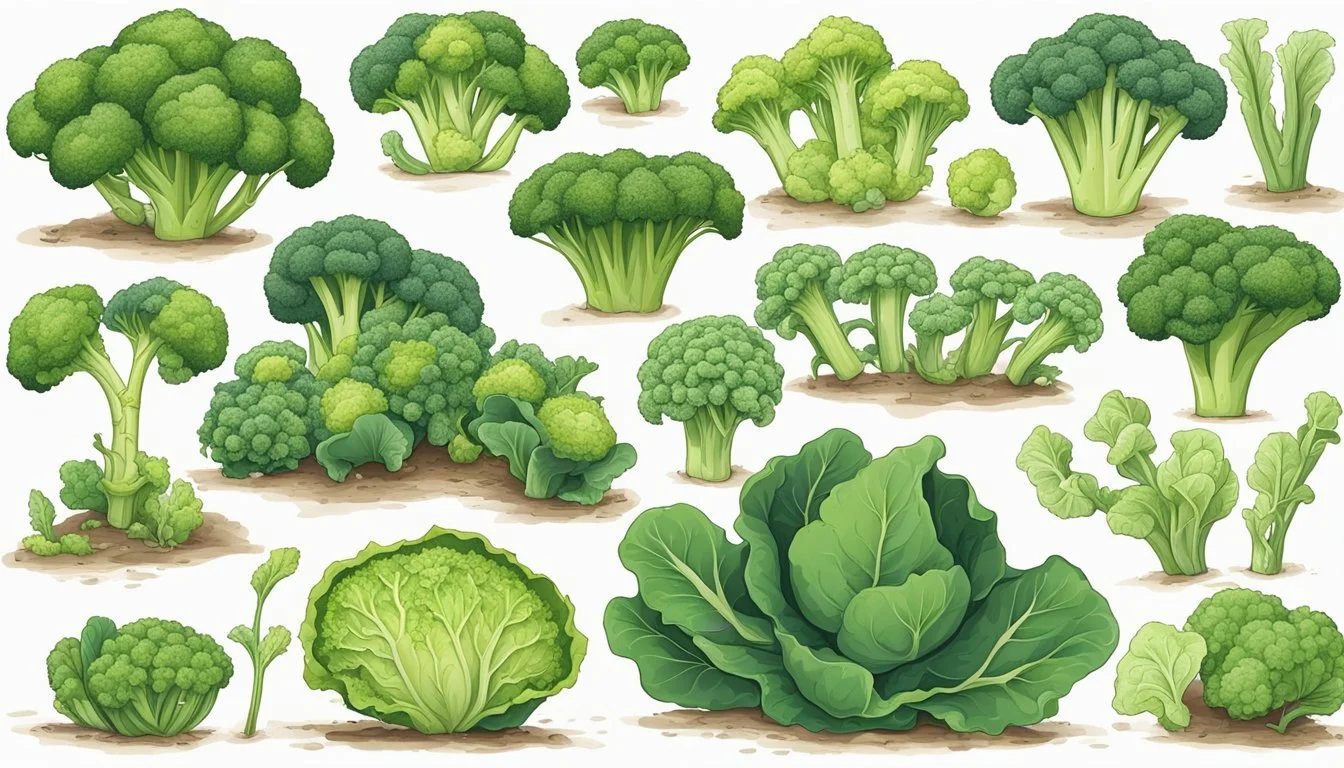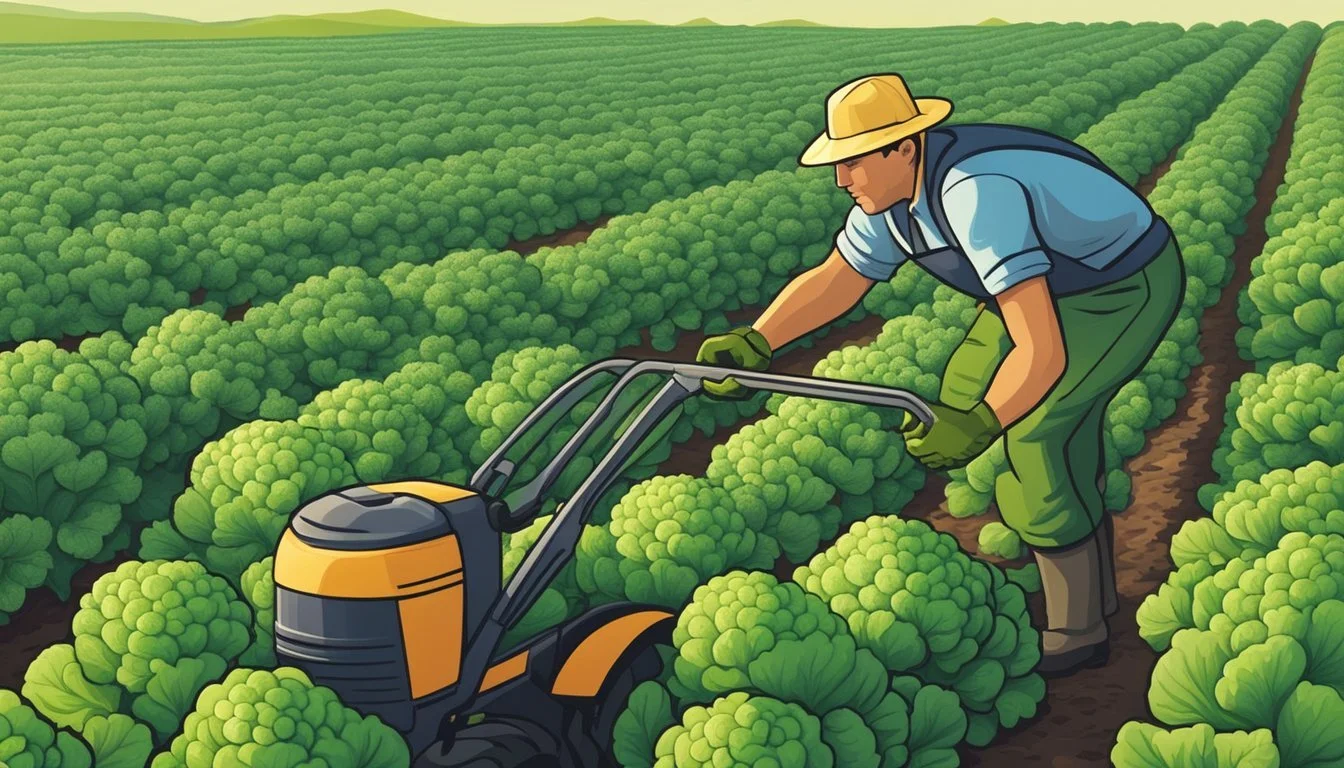Pest Control for Cruciferous Vegetables
Effective Strategies for Broccoli and Cabbage Protection
Cruciferous vegetables, known for their nutritional benefits and distinctive taste, are cultivated worldwide and form a vital part of the global diet. This family of vegetables includes familiar staples such as broccoli (how long does broccoli last?) , cabbage, cauliflower, Brussels sprouts, and kale. However, their broad cultivation and popularity also make them targets for a variety of pests, which can significantly impact yield and quality. Managing these pests is therefore crucial for both commercial farmers and home gardeners aiming to protect their crops.
Effective pest control strategies for cruciferous vegetables are multifaceted, involving preventative measures, physical barriers, and biological controls. For instance, floating row covers can prevent pests from accessing plants, while certain insects can be managed using environmentally friendly methods that minimize harm to beneficial organisms. Understanding the life cycles of common pests like the diamondback moth, which is known to attack these crops, is critical in developing integrated pest management (IPM) plans.
While chemical pesticides are often used, there is increasing interest in sustainable approaches to protect these. Biological approaches and natural pest deterrents are preferred for long-term sustainability and health. The goal is to maintain pest populations at levels that do not cause economic harm while preserving ecological balance. With the right knowledge and tools, growers can effectively safeguard their cruciferous vegetables, ensuring a bountiful and healthy harvest.
Understanding Cruciferous Vegetables
In learning about pest control for cruciferous vegetables, understanding the specific traits, classification, and growth conditions of these crops is crucial. These vegetables belong to the Brassicaceae family and are widely appreciated for their nutritional value and diverse uses.
Classification and Characteristics
Cruciferous vegetables, also known as Brassicaceae or cole crops, encompass a wide range of edible plants. Notable for their cross-shaped flowers, hence the term "cruciferous," these crops share a common characteristic: the production of glucosinolates, compounds responsible for their pungent flavors. Brassica oleracea is one of the most recognized species within this group and has given rise to a variety of common vegetables through selective breeding.
Common Cruciferous Crops
This group includes a variety of vegetables that have become staples in diets around the world. Among them are:
Broccoli (Brassica oleracea var. italica)
Cabbage (Brassica oleracea var. capitata)
Cauliflower (Brassica oleracea var. botrytis)
Brussels sprouts (Brassica oleracea var. gemmifera)
Kale (Brassica oleracea var. sabellica)
Mustard greens (Brassica juncea)
Turnip (Brassica rapa subsp. rapa)
Radish (Raphanus sativus)
These crops not only add diversity to the vegetable garden but also play an essential role in crop rotation systems due to their unique growth requirements and pest resistance characteristics.
Growth Requirements
Cruciferous vegetables thrive in cool climates, generally preferring temperatures between 55°F and 75°F. They are typically grown in temperate zones but some varieties can tolerate slightly warmer climates. Soil quality plays a significant part in their successful cultivation. These crops favor:
Well-drained, fertile soil
Slightly acidic to neutral pH (approximately 6.0-7.5)
Consistent moisture levels
Understanding the growth requirements is key to both healthy crops and effective pest management strategies for these vegetables.
Pest Identification and Life Cycles
Successful management of pests in cruciferous vegetables hinges on accurate identification of the insects and a thorough understanding of their life cycles. Recognizing the specific pests and the damage they inflict allows for timely and targeted interventions.
Common Insect Pests of Cruciferous Crops
Cruciferous vegetables are susceptible to a variety of insect pests. Cabbage loopers (Trichoplusia ni) and imported cabbage worms (Pieris rapae) are caterpillars that chew foliage, leaving behind holes and other marks of destruction. Diamondback moth caterpillars (Plutella xylostella) also target these crops, as do flea beetles, small insects that jump like fleas and create shot-hole patterns in leaves.
Aphids, such as the Brevicoryne brassicae, are sap-sucking pests that weaken plants and can transmit diseases. Whiteflies and mites also feed on plant juices, causing further stress to the plants. Cutworms and armyworms are notorious for severing young plants at the stem or chewing on leaves, respectively.
Pest Life Cycles and Behavior
Many of these pests go through complete metamorphosis with life stages that include egg, larva, pupa, and adult. For example, the diamondback moth completes its life cycle in roughly 32 days, going through several larval instars before pupating. Cabbage maggots (Delia radicum), the larvae of a fly, transition from eggs laid at the base of plants to burrowing larvae that feed on roots.
The flea beetle passes through a winter pupal stage before emerging in spring to feed on young plants. Aphids can reproduce rapidly, often without mating, leading to swift increases in population size under favorable conditions.
Identifying Damage on Plants
Identifying insect damage on plants is vital for control measures. Chewed leaves and holes are indicative of caterpillar activity, while the presence of frass (insect droppings) often confirms their presence. Sap-sucking insects such as aphids, whiteflies, and mites leave behind stippling patterns on leaves and can cause yellowing or curling.
Examine the undersides of leaves for eggs or the small, sesame seed-sized pupae of insects like the diamondback moth. Burrowing pests such as cabbage maggots will leave trails in the roots and stems, and affected plants may show signs of wilting or stunted growth.
Cultural Control Methods
Cultural control methods involve agricultural practices that reduce pest problems in cruciferous vegetables like broccoli and cabbage, through means other than chemical pesticides. These strategies are designed to disrupt the life cycle of garden pests, making the environment less conducive to their survival and reproduction.
Crop Rotation and Planting Strategies
Crop rotation is a fundamental aspect of pest management for crucifers, as it helps break pest and disease cycles. For instance, rotating brassicas with non-host crops such as lettuce or tomatoes can significantly reduce the buildup of brassica-specific pests and diseases in the soil. Intercropping, the practice of growing different crops in proximity, can further confuse pests and reduce infestations.
Sanitation and Weed Management
Effective sanitation involves the removal of plant debris and weeds that can harbor pests or disease. Weeds, especially brassica weeds, can provide a refuge for pests such as flea beetles. By keeping the field free of these weeds, farmers significantly reduce pest pressure on young seedlings and transplants. Additionally, eliminating diseased plants promptly prevents the spread of pathogens to healthy brassicas.
Physical Barriers and Exclusion Techniques
Floating row covers act as physical barriers that prevent pests from reaching the plants. Made of lightweight fabric, these covers are especially useful to protect young seedlings and young transplants from being attacked by garden pests. Securing the edges of row covers ensures that pests such as root maggots, which target the roots of Brassica oleracea species, cannot infiltrate and cause damage.
Chemical Control Options
In the management of pests in cruciferous vegetables, farmers utilize a variety of chemical control options. Knowledge of the types of chemicals, strategic application, and proactive resistance management are fundamental for effective pest control.
Understanding Pesticides and Insecticides
Pesticides, including insecticides, are vital in controlling the diverse range of insects that attack cruciferous crops. Insecticides are chemicals specifically targeting insect pests, whereas pesticides can be broader, including fungicides and herbicides. A commonly used biological insecticide is Bacillus thuringiensis (Bt), a soil bacterium known for its effectiveness against caterpillars. Neem oil, derived from the neem tree, is another biopesticide that acts as an antifeedant and growth disruptor for insects.
Application Techniques and Timing
The manner and timing of pesticide application are as crucial as the selection of the product itself. Farmers must;
Ensure the direct contact of insecticides with the pests.
Apply at the right developmental stage of the crop and pest for maximum effectiveness.
Consider environmental conditions, as weather can greatly affect the efficacy and safety of the pesticide use.
Resistance Management
Resistance management is a critical aspect of using chemical controls. Pests can develop resistance to pesticides, rendering them ineffective. To combat this, farmers must:
Rotate chemicals with different modes of action.
Use pesticides judiciously and only as needed.
Integrate other pest management strategies, such as biological controls or cultural practices, to reduce reliance on chemicals alone.
Biological Control Strategies
Biological control strategies entail the use of living organisms such as beneficial insects, biological pesticides, and habitat management measures to regulate pest populations in cruciferous vegetables like broccoli, cabbage, kohlrabi, and collards. These methods aim to maintain pest numbers below damaging levels while respecting the surrounding ecosystem.
Beneficial Insects and Predators
Beneficial insects and predators play a pivotal role in controlling pests of cruciferous vegetables. For example, ladybugs are efficient predators that feed on aphids, a common pest in cruciferous crops. In the UK, entomologists promote the use of local beneficial insects to target pests effectively. Additionally, the entomopathogenic nematode can parasitize a variety of soil-dwelling larvae, including those of the cabbage moth (Trichoplusia ni), which poses a threat to cabbage and other crucifers, specifically targeting their larvae without affecting non-target species.
Biological Pesticides and Microorganisms
The use of biological pesticides and microorganisms involves introducing or enhancing pathogens that naturally infect pest species. These biopesticides can include bacteria, fungi, viruses, or protozoans, which cause disease within the pest population. An example is the bacterium Bacillus thuringiensis, which produces toxins lethal to certain insect larvae but has minimal impact on beneficial insects and non-target organisms.
Habitat Management for Natural Enemies
Habitat management seeks to optimize the living conditions for natural enemies of pests. This can be accomplished by planting floral resources that provide nectar and pollen for adult predators and parasitoids, or by creating shelter such as hedgerows to protect them from adverse weather and wind. Additionally, maintaining plant diversity within and around cruciferous vegetable plots ensures a stable environment for these beneficial species, which enhances their ability to locate and suppress pest populations on host plants.
Integrated Pest Management (IPM)
Integrated Pest Management (IPM) is a comprehensive approach to controlling pests in cruciferous vegetable farming that prioritizes environmental protection and economic viability. It involves a combination of practices tailored to local conditions, aimed at reducing reliance on chemical pesticides and enhancing crop health.
IPM Principles and Practices
IPM integrates multiple strategies to manage insect pests, diseases, and other challenges to maximize yield and quality in crops like broccoli and cabbage. Crop rotation helps prevent the build-up of pests and spores, disrupting life cycles. The use of transplants may enhance plant health, thereby offering greater protection against pests. Irrigation practices must be managed to avoid creating favorable conditions for disease development.
Monitoring and Thresholds for Intervention
Regular monitoring is essential for early detection of pest populations or disease symptoms. IPM sets specific action thresholds to determine when interventions are necessary. This means that pest control actions are taken not at the sighting of a single pest but when pest levels reach a point where they could cause economic damage. Techniques such as pheromone traps or visual inspections are commonly employed. Integrated Pest Management of Cruciferous Vegetables - ResearchGate offers insight into practical monitoring methods.
Record Keeping and Decision Making
Meticulous record keeping forms the backbone of effective IPM. By documenting pest occurrences, control measures, and plant responses, farmers can analyze trends, evaluate the effectiveness of their strategies, and make informed decisions. Records assist in identifying the most economical and least environmentally-disruptive solutions, thereby optimizing the yield and health of cruciferous crops.
Dealing with Specific Pests
Effective pest management in cruciferous vegetables requires targeted strategies for various insects. Each pest differs in its life cycle, damage potential, and control methods. Understanding these specifics is crucial for successful intervention.
Management of Cole Crop Pests
Cole crop pests such as cabbage loopers and aphids can cause significant damage to vegetables like broccoli and cabbage. Thorough monitoring and employing Integrated Pest Management (IPM) practices are essential. Early detection and intervention can prevent large-scale infestations, conserving the yield and quality of the crops.
Flea Beetle Biology and Control
Flea beetles are a common adversary for cruciferous vegetable growers, particularly challenging due to their mobility and resilience. Adults lay eggs near the base of the plant, and upon hatching, the larvae feed on the roots. Control methods include removing plant debris to disrupt the life cycle, using row covers to protect young plants, and, if necessary, applying insecticides with great discretion to minimize environmental impact.
Cabbage Looper and Worm Control
Two members of the Lepidoptera order, the cabbage looper and the cabbage worm, are known for their voracious appetite for cruciferous leaves. Crop rotation and biological control agents like Bacillus thuringiensis (Bt) are effective strategies. Physical methods such as hand-picking caterpillars and destruction of affected leaves should be implemented alongside chemical controls where justified.
Aphid Infestation Management
Aphids pose a distinct threat by not only feeding on the plants but also by transmitting viruses. They thrive in a colony, so tackling them promptly is paramount. Natural predators, such as lady beetles and lacewings, play a significant role in keeping aphid populations in check. For persistent aphid infestations, insecticidal soap and neem oil can be used as environmentally sensitive options.
Disease Management for Crucifers
Effective disease management for crucifers involves identifying common diseases, applying preventative measures and treatments, and understanding the role of plant debris and soil health. These practices are crucial for maintaining the health of crops such as broccoli and cabbage.
Common Diseases and Fungal Pathogens
Cruciferous vegetables are susceptible to a range of diseases, predominantly caused by fungal pathogens. One such disease is Alternaria leaf spot, which is characterized by dark, necrotic lesions on leaves and can be devastating for crops like cabbage. The disease is often exacerbated by cool temperatures and high humidity.
Another disease, target spot, caused by the fungal pathogen Corynespora cassiicola, displays symptoms of concentric rings on leaves leading to premature defoliation. The spread of these diseases is facilitated by rain splash, which can disperse infectious spores across wide areas.
Prevention and Treatment Options
The prevention of diseases in cruciferous vegetables can involve strategies such as using infected seed, which is a common vector for pathogens, so ensuring seed sanitation is key. Fungicides may also be utilized to manage the spread of diseases, although it is critical to follow recommended application rates and schedules to prevent resistance.
Cultural practices such as crop rotation can significantly reduce the presence of fungal pathogens in the soil. Moreover, the implementation of resistant varieties where available can be an effective method to prevent outbreaks.
Role of Plant Debris and Soil Health
Soil health plays a pivotal role in disease management for crucifers. Fungal pathogens often overwinter or persist in infected plant debris, so thorough removal of crop residues and weeds can decrease the inoculum load in the soil.
Improving soil structure and fertility through proper fertilization and addition of organic matter can also promote a healthy crop that is less susceptible to diseases. Additionally, maintaining optimum soil moisture and proper irrigation practices can limit the conditions fungi require to thrive.
Seasonal and Environmental Considerations
Effective pest management for cruciferous vegetables requires understanding the intricate relationship between pests and environmental factors throughout the changing seasons.
Weather Impact on Pest Populations
Environmental conditions, particularly temperature and weather, exert significant influence on pest dynamics. For instance, flea beetles are drawn to crucifers as temperatures rise in early spring, while the cabbage maggot thrives in cooler soil temperatures.
Rainfall, especially when heavy, can impact pests differently. High humidity and rain splash can promote disease proliferation, which in turn affects pest populations indirectly. Conversely, a downpour may dislodge or drown certain insects, temporarily reducing their threat level.
Adjusting Practices for Climatic Conditions
Growers must adapt their pest control tactics to the current climatic conditions. In periods of high wind and rain, for example, soil-applied treatments may be washed away, necessitating a switch to systemic or foliar-applied pesticides. During dry, warm periods, pests like the diamondback moth larva may proliferate, requiring increased vigilance and perhaps more frequent interventions.
To account for temperatures, pest control strategies often include monitoring degree days to predict pest life cycle events more accurately. This is a way to ensure that pest control measures are timed optimally to interrupt the developmental stages of pests like the cabbage looper, thereby reducing their populations more effectively.
Frequently Asked Questions
In managing pests for cruciferous vegetables, gardeners often seek specific and effective strategies. This section addresses common inquiries with clear and practical information.
What are the common insect pests that affect cruciferous vegetables like broccoli and cabbage?
Cruciferous vegetables are frequently targeted by caterpillars such as the cabbage looper and the imported cabbageworm. Flea beetles also pose a significant threat, especially early in the growing season.
Which natural remedies are effective for managing pests in cruciferous vegetable gardens?
Natural predators like lady beetles and lacewings are effective against aphids on cruciferous vegetables. Planting companion species, such as marigolds or herbs like dill, can also help deter pests.
How can you create a pest control program specifically for cabbage?
A pest control program for cabbage should integrate crop rotation, regular monitoring for pests, and timely application of appropriate insecticides or biological control methods.
What are the best practices for preventing pest infestations in cruciferous crops?
Preventing pest infestations involves maintaining garden hygiene, utilizing floating row covers to exclude insects, and planting pest-resistant varieties. Soil health enrichment is also key to supporting plant defenses.
What insecticides are recommended for controlling cabbage worms and other similar pests?
Insecticides such as Bt (Bacillus thuringiensis), a naturally occurring soil bacterium, can control cabbage worms without harming beneficial insects. Always follow label instructions for safe and effective use.
How do you identify and manage diseases that commonly affect cabbage and other cruciferous vegetables?
Disease identification often starts with the observation of symptoms such as leaf spots or wilting. Management includes practices like crop rotation and resistant cultivars, along with monitoring for virus diseases that can affect these plants.





